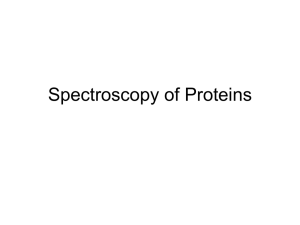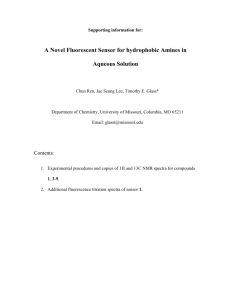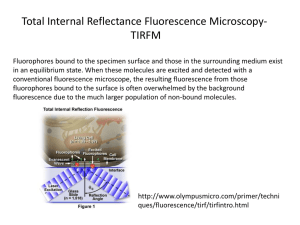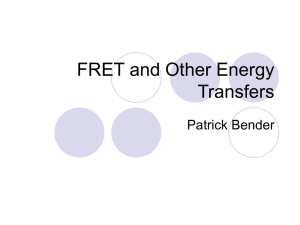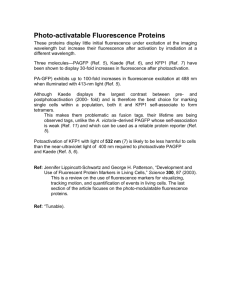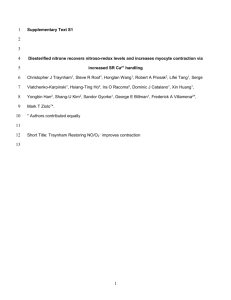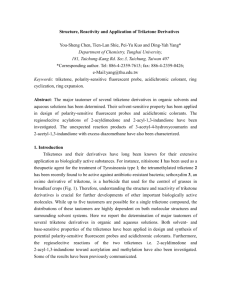Detailed experimental procedures, absorption, fluorescence, 1 H
advertisement
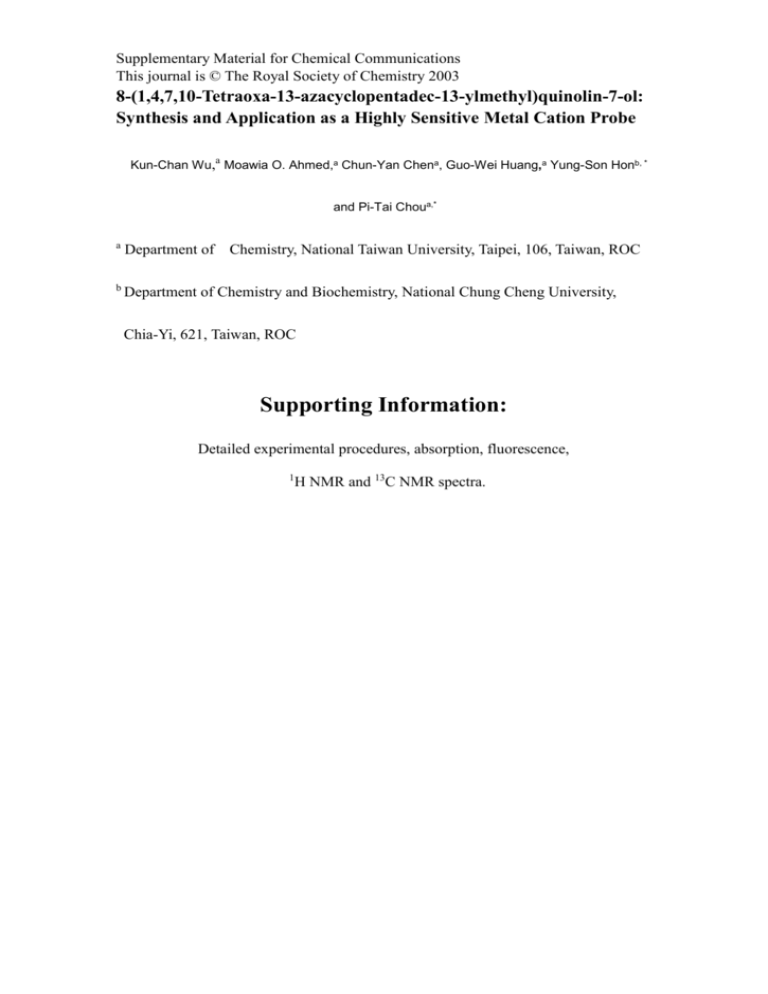
Supplementary Material for Chemical Communications This journal is © The Royal Society of Chemistry 2003 8-(1,4,7,10-Tetraoxa-13-azacyclopentadec-13-ylmethyl)quinolin-7-ol: Synthesis and Application as a Highly Sensitive Metal Cation Probe Kun-Chan Wu,a Moawia O. Ahmed,a Chun-Yan Chena, Guo-Wei Huang,a Yung-Son Honb, * and Pi-Tai Choua,* a Department of Chemistry, National Taiwan University, Taipei, 106, Taiwan, ROC b Department of Chemistry and Biochemistry, National Chung Cheng University, Chia-Yi, 621, Taiwan, ROC Supporting Information: Detailed experimental procedures, absorption, fluorescence, 1 H NMR and 13C NMR spectra. Supplementary Material for Chemical Communications This journal is © The Royal Society of Chemistry 2003 Synthetic Procedures All reactions were performed under nitrogen atmosphere. Solvents were distilled from appropriate drying agents prior to use. Commercially available reagents were used without further purification unless otherwise stated. All reactions were monitored by TLC with Macherey-Nagel pre-coated glassic sheets (0.20 mm with fluorescent indicator UV254). Compounds were visualized with UV light at 254 nm and 365 nm. Flash column chromatography was carried out using silica gel from Merck (230-400 mesh). 1H NMR and 13C NMR in CDCl3 were recorded using a Varian (Unity Plus 400) spectrometer at 400 MHz and 100 MHz, respectively. 8-(1,4,7,10-Tetraoxa-13-azacyclopentadec-13-ylmethyl)quinolin-7-ol (1a) A mixture of 1-aza-15-crown-5 ether (0.6 g, 2.76 mmol) and dibromomethane (1.8 g, 10.35 mmol) was stirred at room temperature for 3 h. To the resulted light yellow solution was added a solution of 7-hydroxyquinoline (0.1 g, 0.69 mmol) in THF (2 mL) and the reaction mixture was stirred at room temperature for 12 h. The reaction mixture was concentrated in vacuo and the residue was redissolved in a minimum amount of dichloromethane and then treated with n-hexane (25 mL) at 0 oC. The precipitate was filtered by sintered glass and washed with hexane. The filtrate was basified by 1 N NaOH and extracted with dichloromethane. The organic layer was dried with MgSO4 and concentrated in vacuo to give the crude product, which was further purified by silica gel column chromatography. Elution with a mixture of methanol/dichloromethane (v/v = 2:98) afforded compound 1a (219 mg, 85%) as a pale yellow oil. 1H NMR (CDCl3, 400 MHz) 2.93 (t, J = 5.6 Hz, 4H), 3.58-3.77 (m, 16H), 4.56 (s, 2H), 7.13 (d, J = 8.0 Hz, 1H), 7.16 (dd, J = 8.0, 4.0 Hz, 1H), 7.58 (d, J = 8.8 Hz, 1H), 7.98 (dd, J = 8.4, 1.6 Hz, 1H), 8.74 (dd, J = 4.0, 2.0 Hz, 1H); 13C NMR (CDCl3, 100 MHz) 53.5 (2o, N-CH2), 54.6 (2o, ArCH2N), 68.8 (2o, O-CH2), 70.3 (2o, O-CH2), 70.4 (2o, O-CH2), 70.8 (2o, O-CH2), 114.3 (3o), 117.8 (3o), 120.2 (3o), 122.6 (3o), 127.9 (3o) 136.1 (3o) 147.7 (3o), 149.2 (3o) 159.8 (3o); IR (KBr, neat) (cm-1): 3434, 2866, 1940, 1672, 1618, 1508, 1482, 1440, 1358, 1316, 1275, 1123; FAB-MS m/z (rel intensity) 377 (M+ + 1, 100%). 8-Diethylaminomethylquinolin-7-ol (1b) A solution of diethylamine (0.4 g, 5.51 mmol) and dibromomethane (3.6 g, 20.67 mmol) was stirred at room temperature for 3 h. To the resulted light yellow solution was added a solution of 7-hydroxyquinoline (0.2 g, 1.38 mmol) in THF (2 mL). The reaction was completed in 4 h at room temperature. The reaction mixture was treated with diethyl ether at 0 oC to precipitate the ammonium salt out. The precipitate was filtered by sintered glass and washed with ether. The filtrate was concentrated in Supplementary Material for Chemical Communications This journal is © The Royal Society of Chemistry 2003 vacuo and the crude product was purified by silica gel column chromatography by elution with a mixture of methanol/dichloromethane (v/v = 2:98) to give compound 1b (283 mg, 1.24 mmol) in 90% yield as a pale yellow solid. 1H NMR (CDCl3, 400 MHz) 1.45-1.51 (m, 6H), 3.04-3.28 (m, 4H), 4.93 (s, 2H), 7.27 (dd, J = 8.0, 4.0 Hz, 1H), 7.72 (d, J = 8.8 Hz, 1H), 7.78 (d, J = 9.2 Hz, 1H), 8.08 (dd, J = 8.0, 1.2 Hz, 1H), 8.75 (dd, J = 4.0, 2.0 Hz, 1H); 13C NMR (CDCl3, 100 MHz) 14.6 (1o, CH3), 48.1 (2o, N-CH2CH3), 60.5 (2o, ArCH2N), 108.4 (3o), 118.5 (3o), 120.2 (3o), 122.7 (3o), 130.4 (3o) 136.6 (3o) 147.2 (3o), 149.2 (3o) 170.4 (3o); IR (KBr, neat) (cm-1): 3442, 2928, 2852, 2366, 2338, 1638, 1460, 1377; FAB-MS m/z (rel intensity) 231 (M+ + 1, 100%). Spectroscopic and Dynamic Measurements: Anhydrous salts were used for both absorption and fluorescence titration experiments. This was done by drying salts in a vacuum oven (60oC) overnight, followed by preparing the stock solution in a dry box under nitrogen atmosphere. Solvent (CH3CN) was distilled from CaH2 prior to use. Steady-state absorption and emission spectra were recorded by a Hitachi (U-3310) spectrophotometer and an Edinburgh (FS920) fluorimeter, respectively. The excitation light source of the fluorimeter has been corrected by the Rodamine B spectrum. In addition, the wavelength-dependent characteristics of the monochromator and photomultiplier have been calibrated by recording the scattered light spectrum of the corrected excitation light from a diffused cell in the 220-700 nm ranges. In order to obtain the precise extinction coefficient five different concentrations ranging from 5 × 10-5 M to 5 × 10–7 M were performed. Quinine sulfate/1.0 N H2SO4 was used as a reference, assuming a yield of 0.564 with 360 nm excitation, to determined fluorescence quantum yields of the studied compounds in solution. Nanosecond lifetime studies were performed by an Edinburgh FL 900 photon-counting system with a hydrogen-filled/or a nitrogen lamp as the excitation source. Data were analyzed using the nonlinear least squares procedure in combination with an iterative convolution method. The emission decays were analyzed by the sum of exponential functions, which allows partial removal of the instrument time broadening and consequently renders a temporal resolution of ~ 200 ps. The setup of picosecond dynamical measurements consists of a femtosecond Ti-Sapphire oscillator (82 MHz, Spectra Physics). The fundamental train of pulses was pulse-selected (Neos, model N17389) to reduce its repetition rate down to typically 0.8-8 MHz, and then used to produce second harmonics (380-400) as an excitation light source. A polarizer was placed in the emission path to ensure that the polarization of the fluorescence was set at the magic angle (54.7o) with respect to that Supplementary Material for Chemical Communications This journal is © The Royal Society of Chemistry 2003 of the pump laser to eliminate the fluorescence anisotropy. An Edinburgh OB 900-L time-correlated single photon counting system was used as a detecting system. The time-dependent fluorescence data were analyzed by the sum of exponential functions incorporating the excitation-pulse profile with an iterative convolution method, which allows partial removal of the instrument time broadening and consequently renders a temporal resolution of ~ 15 ps. For dynamical measurements sample solution was degassed via three freeze-pump-thaw cycles to avoid the oxygen quenching interference. Absorption and fluorescence spectra of 1b in CH3CN. The peak wavelengths of the multiple fluorescence were marked by N, A and Z to denote normal, dialkylamino nitrogen protonated and zwitterionic species, respectively. The excitation wavelength for the fluorescence measurement was 335 nm. Abs 0.2 0.0 300 350 400 450 Wavelength (nm) A Relative Intensity 10 5 Z N 0 400 500 Wavelength (nm) 600 Supplementary Material for Chemical Communications This journal is © The Royal Society of Chemistry 2003 UV-Vis titration of 1a with NaClO4 Figure 1 in the text shows the absorption spectra of 1a (2.2 x 10-5 3CN by adding various NaClO4 concentrations (Cg): a. 15, b. 25, c. 45, d. 85, e. 165, f. 320 g. 645 equiv (1 equiv = 2.9 x 10-6 . The plot of the relationship between the measured absorbance A as a function of the added NaClO4 concentration, Cg, can be expressed by M A0 A A0 c M 1 1 K a [C g ] (1)i where M and c are molar extinction coefficients of the free 1a and 1a/Na+ complex, respectively at a selected wavelength. A0 denotes the absorbance of free 1a at that wavelength. Fluorescent titration of 1a with NaClO4 An Edinburgh FS 920 spectrophotometer was used for the fluorescence titration study (Figure 2). The fluorescence spectra (ex = 340 nm) of 1a (2.2 x 10-5M) were taken as a function of NaClO4 concentrations (Cg): a. 15, b. 25, c. 45, d. 85, e. 165, f. 320 g. 645 equiv (1 equiv = 2.9 x 10-6 The relationship between the measured fluorescence intensity F and Cg in a selected wavelength can be expressed by 1 F0 MM 1 F F0 ( C C M M ) K a C g (2)i where F0 and F denote the measured fluorescence intensity prior and after adding NaClO4. M and C are fluorescence quantum yields of the monomer and complex, respectively, and are assumed to be constant throughout the titration. The plot of F0/(F-F0) versus 1/Cg shown below exhibits good linear behavior, supporting the assumption of the 1:1 complex formation. A best linear least-squares fit gives the slope and intercept to be 1.9 10-4 and 1.07, respectively. Consequently, a Ka value of 5600 was obtained, which is consistent with the value of 4.5 103 M-1 deduced in the absorption titration study (see text). Supplementary Material for Chemical Communications This journal is © The Royal Society of Chemistry 2003 6 5 F0/(F0-F) 4 3 2 1 0.0 0.5 1.0 -4 1.5 -1 2.0 2.5 1/Cg (X 10 ) (M ) UV-Vis titration of 1a with Ca(ClO4)2 Under the existence of an equilibrium among 1a, 1a/Ca2+ and 1a/(Ca2+)2, the complexation scheme can be expressed as H + G HG + G K1 K2 HG (3) HG2 (4) Where G represents Ca2+ concentration, H, G and HG2 denote 1a, 1a/Ca2+ and 1a/(Ca2+)2, respectively. The original concentration of H was prepared to be C0. After adding Cg M of G, the concentrations of HG and HG2 existing in the equilibrium were denoted by x and y M, respectively. Using a 1.0 cm path-length cell, eq. (5) can be derived by solving eqs. (3) and (4), assuming that Cg is > x + 2y throughout the titration. 1 C0 (5) C g C g K 2 C 2g K1 x In eq. (5), K1 and K2 denote the association constants for (3) and (4), respectively. The absence of zwitterion (1a/(Ca2+)2 complex) 425-nm absorption band during the 1:1 1a/Ca2+ complex formation (as indicated by the growth of the 365-nm absorption band, see Figure 3) led us to propose K1 to be >> K2. Therefore, at relatively low [Ca2+], K 2 C g2 term can be neglected and one should obtain an expression identical with eq. (1). This viewpoint can be supported by the linear plot of A0/(A-A0) at 365 nm as a function of inverse of the added Ca(ClO4)2 concentrations, 1/[Cg], of a. 1, b. 3, Supplementary Material for Chemical Communications This journal is © The Royal Society of Chemistry 2003 c. 5, d. 7, e. 10, equiv (1 equiv = 1.4 10-6 shown below. Consequently, an association constant K1 of ~5.5 104 M-1 was deduced according to eq. (1). 1.0 A0/(A-A0) 0.8 0.6 0.4 0.2 0 1 2 3 4 -5 5 -1 6 7 8 1/Cg(x10 )(M ) To solve HG2 during the titration we can substitute obtain (6) 1 1 1 1 C0 1 2 y K1 K 2 C g K 2 C g 1 K2Cg into eq. (5) to x y (6) Since the 425-nm band is free from the absorbance of 1a and 1:1 1a/Ca2+ species, the relationship between the measured absorbance at 425 nm (A425 with extinction coefficient of 425) and Ca2+ concentration (Cg) can be expressed as 425C 0 A425 1 K 1 K 2 C g 1 2 1 1 1 K2 Cg (7) C0 425 can be treated as the absorbance of HG2 at 425 nm in a 1 cm path-length cell when excess amount of G is added so that equilibrium shifts to HG2 exclusively. The C 1 Plot of 425 0 versus depicted below was then fitted by eq. (7). In this fit K1 A425 Cg was fixed to be 5.5 104. The best fit gives a K2 value to be 4.6 103, supporting the assumption of K1 >> K2. Supplementary Material for Chemical Communications This journal is © The Royal Society of Chemistry 2003 -2 425C0/A425 (X 10 ) 0.4 0.2 0.0 0.0 0.5 1.0 -5 -1 1/Cg (X 10 ) (M ) UV-Vis titration of 1b with Ca(ClO4)2 Following the same method described for NaClO4, inset of Figure 3 in the text shows the absorption spectra of 1b (3.2 10-5 3CN by adding various Ca(ClO4)2 concentrations (Cg): a. 1, b. 3, c. 5, d. 7, e. 10, f. 13, g. 30 equiv (1 equiv = 1.4 10-5 . The plot of the relationship between the measured absorbance A as a function of the added CaClO4 concentrations reveals a straight line. Consequently, an association constant Ka of ~1.4 103 M-1 was deduced from eq. (1). 1.8 1.5 A0/(A-A0) 1.2 0.9 0.6 0.3 0.0 0 2 4 -4 -1 1/Cg (x 10 ) (M ) 6 8 Supplementary Material for Chemical Communications This journal is © The Royal Society of Chemistry 2003 Reference: i. P. T. Chou, G. R. Wu, C. Y. Wei, C. C. Cheng, C. P. Chang, F. T. Hung, J. Phys. Chem. B 2000, 104, 7818.
